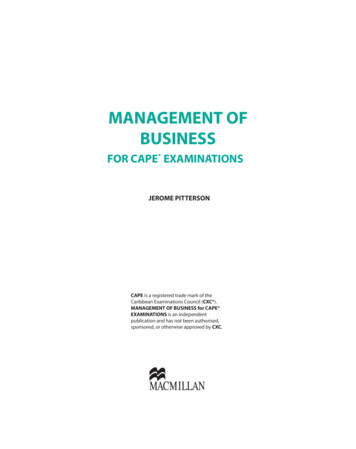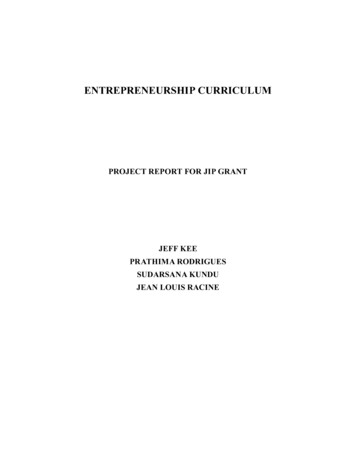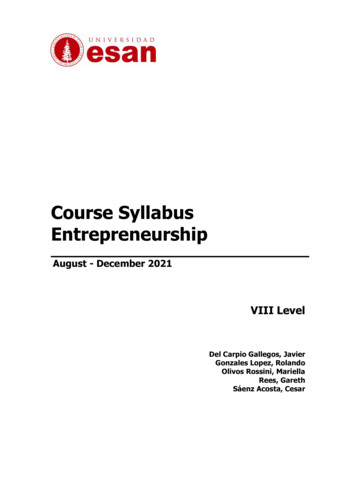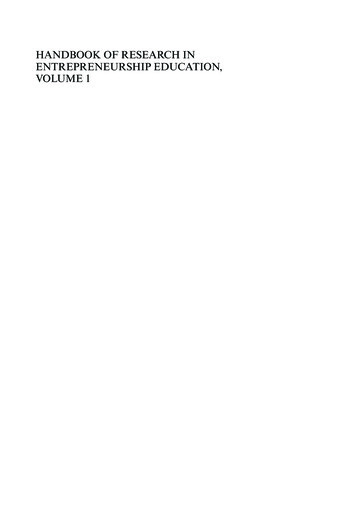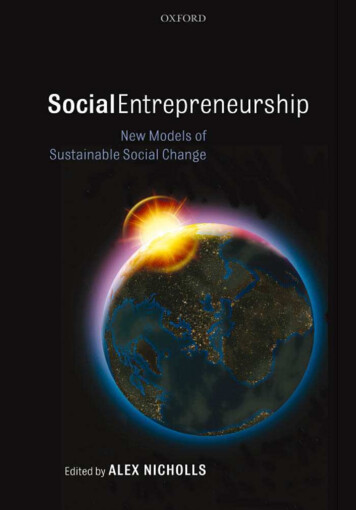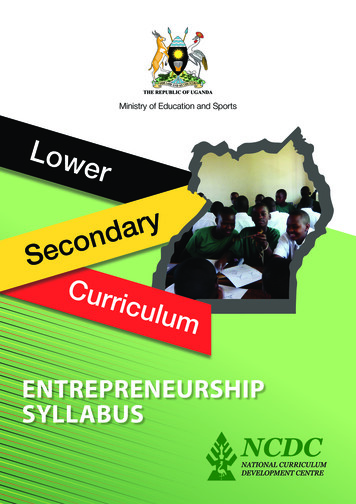
Transcription
LowMinistryofof Education,Education andScience,SportsMinistryTechnology and S
ENTREPRENEURSHIP SYLLABUSCONTENTSINTRODUCTION Introduction2 Background to the new curriculum3 Key Changes4 The new curriculum6- Key Learning Outcomes- Values- Generic Skills- Generic Skills within Entrepreneurship- Cross-cutting Challenges- Entrepreneurship within the new curriculum- Time allocation- Rationale- Teaching and Learning: Entrepreneurship667889999 The Entrepreneurship Syllabus10 Detailed Syllabus12 Assessing Entrepreneurship52- Examinations- Formative Assessment- How do we find the opportunityto make formative assessments?- Generic Skills- Attitudes- Record keeping535354545454Glossary of Key Terms57 The UNESCO Education Strategy (2014 – 2021) advocates for ahumanistic and holistic vision of education as a fundamentalhuman right that is essential to personal and socio-economicdevelopment. UNESCO further recommends, societies that arejust, inclusive, peaceful and sustainable by 2030. The UgandaVision 2040 aims to transform Uganda into a modern andprosperous country, while the NDP recognises the existingweaknesses in education, including the low efficiency andvariable quality at the secondary level. The SustainableDevelopment Goal 4 advocates for inclusive and qualityeducation, while the National Development Plan II focuses onenhancement of human capital, development, strengtheningmechanisms for quality, effective efficient service delivery andimprovement of quality and relevance of skills development.The NRM Manifesto (2016-2021), emphasises continuousassessment examination systems , strengthening soft skills,which promote self-esteem, conscientiousness and a generallypositive attitude to work, promoting e-learning and computerliteracy in order to enhance learning outcomes. All these arelacking and where they exist it is at a minimum level.In alignment with the above, the Education and Sports SectorStrategic plan (2017/20) advocates for delivery of equitable,relevant and quality education for all. The current secondaryschool curriculum of Uganda, although highly regardedby some, is focused on the needs of a tiny academicallyoriented elite yet the needs of the majority of learners needto be the focus. The Ministry of Education and Sports (MoES)through the National Curriculum Development Centre(NCDC) therefore, undertook a review of the Lower SecondaryCurriculum, aimed at providing a learning environment,opportunities, interactions, tasks and instructions that fosterdeep learning by putting the learner at the centre of thelearning experience. This is in line with aims of secondaryeducation in Uganda as outlined opposite.The aims of secondary education in Uganda are to: Instill and promote national unity, an understanding ofthe social and civic responsibilities, strong love and carefor others and respect for public property, as well as anappreciation of international relations and beneficialinternational co-operation; Promote an appreciation and understanding of the culturalheritage of Uganda including its languages; Impart and promote a sense of self discipline, ethical andspiritual values, personal and collective responsibility andinitiative;2
THE LOWER SECONDARY CURRICULUM Enable individuals to acquire and develop knowledge andan understanding of emerging needs of society and theeconomy; Provide up-date and comprehensive knowledge intheoretical and practical aspects of innovative production,modern management methods in the field of commerceand industry and their application in the context of socioeconomic development of Uganda; Enable individuals to develop basic scientific,technological, technical, agricultural and commercial skillsrequired for self-employment; Enable individuals to develop personal skills of problemsolving, information gathering and interpretation,independent reading and writing, self improvementthrough learning and development of social, physicaland leadership skills such as are obtained through games,sports, societies and clubs; Lay the foundation for further education;The reform also aimed at reducing the content overloadand contact hours in the classroom so as to create time for:research and project work; talent development and creativity;allowing for emerging fields of knowledge across all subjectsand doing away with obsolete information. There was a needto address the social and economic needs of the countrylike the mining sector, tourism, services provision, scienceand technology development and to ensure rigorous careerguidance programme to expose learners to the relatedsubjects. This will enable learners to make informed choices asthey transit and to equip them with knowledge and skills thatwill enhance their competitiveness in the global value chain.To meet these requirements, the reforms are based on: The development of a holistic education for personal andnational development based on clear shared values A commitment to higher standards, deeper understandingand greater opportunities for learners to succeed Enable the individual to apply acquired skills in solvingproblems of community, and to develop a strong sense ofconstructive and beneficial belonging to that community; A focus on the key skills that are essential to work, tolearning, and to life, and which will promote life-longlearning Instill positive attitudes towards productive work andstrong respect for the dignity of labour and those whoengage in productive labour activities; An integrated and inclusive approach that will develop theability to apply learning in practical situations. Develop a positive attitude towards learning as a lifelongprocess.BACKGROUND TO THENEW CURRICULUMThe reform was based on the Education Sector Strategic Plan(ESSP), 2009 – 2018) which set out strategies to improve thequality and relevance of secondary education. The ESSP’s subobjective 2.2 was to ensure that “Post-primary students [are]prepared to enter the workforce and higher education”. Thisis also in line with the current strategic plan of 2017-2020. Toachieve this objective, one of the Ministry’s strategies was torevise the curriculum and improve instruction and assessmentby eliminating the short comings in the current curriculum.The review focused on: producing a secondary schoolgraduate who has the competences that are requiredin the 21st century; promoting values and attitudes;effective learning and acquisition of skills in order to reduceunemployment among school graduates.The ESSP further outlines what the reforms imply:“This reform will necessitate a sweeping revision ofthe general secondary curriculum, away from strictlyacademic learning objectives that are thought to preparestudents for erudite higher education and towards a setof competencies that serve both those who continuetheir education after S4 and those who choose to enterthe workforce. The new curriculum will enable learners toacquire specific vocational skills that they can use oncethey enter the world of work. The new curriculum willhelp learners make informed decisions as citizens andfamily members, and it will give those who continue withtheir education, either immediately in S5 or later in life,the learning skills they need to think critically and studyefficiently.”3
ENTREPRENEURSHIP SYLLABUSKEY CHANGESThe key change in the new curriculum is a move from aknowledge-based curriculum to a competence and skillbased curriculum. It is no longer sufficient to accumulate largeamounts of knowledge. Young people need to develop theability to apply their learning with confidence in a range ofsituations. They need to be able to use knowledge creatively. Alevel of competence is the ability to use knowledge rather thanjust to acquire it. This requires an active, learner-centred ratherthan passive, teacher-centred approach.This approach to teaching and learning is in support of theSustainable Development Goals (SDG’s), otherwise known asthe Global Goals. These are a universal call to action to endpoverty, protect the planet and ensure that all people enjoypeace and prosperity. The key changes in the curriculum willensure that Uganda is making good progress towards SDG 4 inparticular which aims to ensure inclusive and equitable qualityeducation and promote lifelong learning opportunities for all.The change can be summarised in the following diagrams.PREVIOUS KNOWLEDGE-BASED DENTSTUDENTTEST AND SUMMATIVE ASSESSMENTKnowledge-based teaching was based on transferring knowledge from the teacher to the students. The teacher hadknowledge and transferred this knowledge to the students by lecturing, talking, asking them to read the text book or writingnotes on the board for the students to copy and learn. Students acquired the knowledge, often without fully understanding it, andwere tested at the end of a unit, term or school course to see if they had remembered it. The knowledge was based mainly on theknowledge in the subjects traditionally taught at University, and little attempt was made to make it relevant to young people’sown lives. The whole education system was seen by many people as a preparation for University, but the vast majorityof learners never reach university. The new curriculum will cater for this majority as well as those who later go on to University.4
THE LOWER SECONDARY CURRICULUMNEW COMPETENCE BASED CURRICULUMACTIVITYSTIMULUS MATERIAL, LEARNERS’ EXPERIENCE,PROBLEM-SOLVING, INVESTIGATION, GROUP ACTIVITIES,EXPLORATION, EXPERIMENTS, FIELD EEDBACK AND INTERACTIONFORMATIVE ASSESSMENTIn the new competence-based approach, the “student” becomes a “learner”. The new Learning Outcomes can only beachieved through active engagement in the learning process rather than simply absorbing knowledge given by the teacher.The teacher needs to build on the learners’ own knowledge and experience and create Learning Activities through whichlearners can explore the meaning of what is being learned and understand how it is applied in practical situations.Teaching and learning becomes a two way process of dialogue between the Teacher and Learners. Learners also learn fromeach other through discussion. Assessment also becomes a two way process of formative assessment; not just to give gradesbut to find out problems the learners may be having and help to solve them.5
ENTREPRENEURSHIP SYLLABUSTHE NEW CURRICULUMThe new curriculum focuses on four “Key Learning Outcomes”of: self – assured individuals; responsible and patrioticcitizens; lifelong learners; positive contributors to society.The curriculum emphasises knowledge, application andbehavioural change. It is based on a clear set of values whichmust be imparted to learners during the learning process.At the heart of every subject there are generic skills that allowdevelopment into life-long learners. Besides, there are alsocross cutting challenges that are embedded across subjectsto enable learners understand the connections between thesubjects and complexities of life.Key Learning OutcomesPositive contributors to society who:The new curriculum sets out ‘Key Learning Outcomes’ that sumup the expectations of the curriculum as a whole, and set outclearly the qualities that young people will develop. Demonstrate knowledge and understanding of theemerging needs of society and the economyBy the end of the educational process, young people will become: Understand how to design, make and critically evaluateproducts and processes to address needsSelf-assured individuals who: Demonstrate self- motivation, self-management andself-esteem Know their own preferences, strengths and limitations Adjust their behaviour and language appropriately todifferent social situations Relate well to a range of personality typesResponsible and patriotic citizens who: Cherish the values promoted in the curriculum Promote the development of indigenous culturesand languages and appreciate diversity, equity andinclusiveness Have acquired and can apply the Generic Skills Appreciate the physical, biological and technologicalworld and make informed decisions about sustainabledevelopment and its impact on people and theenvironment.ValuesThe new curriculum is based on a clear set of values. Thesevalues underpin the whole curriculum and the work ofschools. They are also the values on which learners need tobase their lives as citizens of Uganda. Peace and harmony Integrity and honesty Apply environmental and health awareness when makingdecisions for themselves and their community Patriotism Are positive in their own identity as individuals and globalcitizens Positive attitude towards work Respect for human rights Self-Control Are motivated to contribute to the well-being ofthemselves, their community and the nationLifelong learners who: Can plan, reflect and direct their own learning Actively seek lifelong learning opportunities for personaland professional development6These values are not taught directly in lessons, nor will they beassessed, but they will inform and shape all teaching and learning.
THE LOWER SECONDARY CURRICULUMGeneric SkillsThe generic skills lie at the heart of every Subject. They are theskills that enable the learner to access and deepen learningacross the whole curriculum. They are the same skills that aresought by employers and which will unlock the world of work.They are the skills that allow young people to develop intolifelong learners who can adapt to change and cope with thechallenges of life in the 21st Century.Young people need to be able to think critically and solveproblems, both at school and at work. They need to becreative and innovative in their approach to learning and life.They need to be able to communicate well in all forms, cooperate with others and also work independently. They needto be able to use functional mathematics and ICT effectively.Critical thinking and problem-solvingCommunication Listen attentively and with comprehension Talk confidently and explain things clearly Read accurately and fluently Write and present coherently Use a range of media to communicate ideaCo-operation and Learning Work effectively in diverse teams Interact effectively with others Take responsibility for own learning Work independently with persistence Manage goals and time Plan and carry out investigations Sort and analyse information Identify problems and ways forwardCalculation and ICT Predict outcomes and make reasoned decisions Use numbers and measurements accurately Evaluate different solutions Interpret and interrogate mathematical data Use mathematics to justify and support decisionsCreativity and innovation Use imaginations to explore possibilities Work with others to generate ideas Suggest and develop new solutions Try out innovative alternatives Look for patterns and make generalisations Use technology to create, manipulate and processinformation Use technology to collaborate, communicate andrefine their work7
ENTREPRENEURSHIP SYLLABUSGENERIC SKILLS WITHIN ENTREPRENEURSHIPThese skills are not separate subjects in themselves; they aredeveloped within the subjects of the curriculum. They alsohelp learning within those subjects. It is when these genericskills are deployed that learning is most effective.The generic skills are a key part of the new curriculum.They have been built into the syllabuses for each of theSubjects, and these Subjects provide the context for the skilldevelopment. Entrepreneurship provides a rich context forlearners to communicate, co-operate, and to think criticallyabout how the world works and to understand the world froman entrepreneurial point of view.The Subjects also provide the contexts for progression withinthe skills. The same skill definitions apply to all year groups,and skills progression is provided by the increasing complexityof the subject matter within each Subject. For example, within‘critical thinking’, learners begin thinking critically about therelatively simple subject matter in Senior 1 and then progressto thinking about the much more complex matters in Senior4. Thus the progression is in the increasing complexity of thematters being thought about.CRITICAL THINKING AND PROBLEM SOLVINGCREATIVITY & INNOVATIONELECTIVE SUBJECTELECTIVE SUBJECTELECTIVE SUBJECTCOMPULSORY SUBJECTCOMPULSORY SUBJECTCOMPULSORY SUBJECTCOMPULSORY SUBJECTCOMPULSORY SUBJECTCOMMUNICATIONSOCIO-ECONOMIC CHALLENGESCITIZENSHIPCross-cutting ChallengesThere are some issues that young people need to learn about, butwhich are not confined to one Subject. These are the ‘Cross-cuttingChallenges’ and they need to be studied across the Subjects. Theseissues develop learners’ understanding of the connections betweenthe Subjects, and so of the complexities of life.The Cross-cutting Challenges identified in the curriculum are: Environmental awarenessHealth awarenessDiversity and inclusion8 Socio-economic challengesCitizenshipThese have been built into the syllabuses of each Subject.The way in which they operate within the Subject is verysimilar to the generic skills. Entrepreneurship provides a verygood context for considering diversity and inclusion, socioeconomic challenges and citizenship.
THE LOWER SECONDARY CURRICULUMENTREPRENEURSHIP WITHIN THE NEW CURRICULUMEntrepreneurship is a compulsory subject in Senior 1 and 2 and an elective subject in Senior 3 and 4.Time allocationENTREPRENEURSHIPSENIOR 1 & 2SENIOR 3 & 42 periods a week4 periods a weekRationaleUganda’s Vision 2040 and the National Development Planemphasizes the importance of developing our ability to use thetechnologies available to us - both emerging and traditional - tobuild our society. This curriculum emphasizes that the learnershould be able to understand and use these technologies, andalso know how to extract value from them. This means that thelearner must have strong skills and should develop competencesto contribute to creating employment opportunities for self andfor others.Uganda has abundant resources which are either unutilised,under-utilised or mis-utilised. Entrepreneurship Education willhelp build the abilities of learners to identify these resources andput them to proper use to make a productive living. This helps toincrease the standards of living of the people.This will go a long way in preparing learners to be self-reliantand productive in the society to meet the demands of thecompetitive market. Entrepreneurship education will also help toutilise and apply the skills from other subjects in order to producegoods and services.Entrepreneurship Education is designed to introduce the learnerto the importance of scanning the environment for opportunitiesand resources, Identifying viable business ventures, starting-up abusiness, managing a business and utilising support services torun a business effectively and successfully.Teaching and Learning: EntrepreneurshipThe thrust of the new syllabuses is experiential and towardsdeeper understanding. The focus in Entrepreneurship is onthe development of the understanding and skills needed todevelop ideas, identify commercial possibilities and to planand develop a business enterprise.The new syllabuses provide learners with a wide range ofcontexts in which to develop this understanding, and thesecontexts are designed to engage the interest of the learnerand to provide opportunities to build life-related knowledge,experience and skills. Teachers are encouraged to go beyondthe textbooks and provide as many meaningful contexts aspossible. The generic skills have been integrated throughoutthe curriculum and can only be acquired through activeapproaches.The role of the teacher is to build on learners’ existingknowledge and experience, but to extend that by posingproblems to the learners. This makes them think about theirown ideas and experiences as well as adding new knowledgeand skills to it.Learners need to interact with real situations inside andoutside the classroom. They need to look at pictures ordiagrams, examine statistics, or read texts from a range ofsources. They need to find out knowledge and ideas forthemselves. They should then be expected to express these intheir own words, not those of the teacher, and so demonstratethat they have understood what they have learnt.In this approach, learners are encouraged to: Be responsible for their own learning Think for themselves and form their own ideas andopinions Become critical thinkers, ready to face new challenges andsituations for themselves9
ENTREPRENEURSHIP SYLLABUSTHE ENTREPRENEURSHIP SYLLABUSProgramme PlannerSENIOR 1AREA OF LEARNINGTerm 1Creating an EntrepreneurialAwarenessTerm 2Scanning the environmentTerm 3Start- up processDURATIONTHEME(NUMBER OF PERIODS)Introduction to Entrepreneurship Education24Businesses in Uganda12Business Ideas and Business Opportunities12Business Start-up Process14Introduction to Government Revenue10TotalSENIOR 2AREA OF LEARNINGTerm 1Business ManagementTerm 2Business ManagementTerm 3Business SupportDURATIONTHEME(NUMBER OF PERIODS)Legal Forms of Business Ownership12Production in Business12Marketing in a Small Business Enterprise24Money and Financial Institutions14Taxation10TotalSENIOR 372AREA OF LEARNING72DURATIONTHEME(NUMBER OF PERIODS)Term 1Business ManagementBusiness Planning48Term 2Business ManagementIntroduction to Principles of Accounting48Term 3Business ManagementIntroduction to Principles of Accounting34Tax Administration14Total10144
THE LOWER SECONDARY CURRICULUMSENIOR 4AREA OF LEARNINGDURATIONTHEME(NUMBER OF PERIODS)Term 1Business supportInsurance48Term 2Business supportInternational Trade48Term 3Business supportTax Compliance40Total136The syllabus details for all subjects are set out in three columns:LEARNING OUTCOMESThe learner should be able to:The knowledge, understanding or skillsexpected top be learned by the end ofthe topicSUGGESTED LEARNING ACTIVITIESThe sort of learning activities thatinclude the generic skills and that willhelp learners achieve the LearningOutcomes.SAMPLE ASSESSMENT ACTIVITIESOpportunities for assessment withinthe learningTeachers should base their lesson plans on the Learning Outcomes using the Suggested Learning Activities as a guide. These arenot the only possible learning activities, and teachers are encouraged to extend these and devise their own that are appropriateto the needs of their class.11
ENTREPRENEURSHIP SYLLABUSDETAILED SYLLABUS FOR ENTREPRENEURSHIPSENIOR 1: TERM 1Theme: Introduction to entrepreneurship educationSUB-TOPIC 1.1: THE ENTREPRENEUR24 PERIODSCompetency: By the end of this topic the learner should be able to:1. appreciate the purpose of studying Entrepreneurship Education2. demonstrate the characteristics of an Entrepreneur.LEARNING OUTCOMESThe learner should be able to:a) understand the purpose ofEntrepreneurship Education. (u)b) identify key characteristics of anentrepreneur. (k)c) assess the benefits of an entrepreneur. (s)SUGGESTED LEARNING ACTIVITIESSAMPLE ASSESSMENT STRATEGY Learners to be given a definition ofEntrepreneurship to discuss. Can they telleach other what they understand in theirown words? Observe the posters produced bylearners to explore how clear they arein describing and persuading people tostudy Entrepreneurship Education. As a group, learners produce a mind-mapto show the purpose of EntrepreneurshipEducation. Observe learners interacting with thevisiting entrepreneur. Do learners askrelevant questions that build on previousanswers during the interview? Learners design a poster to advertise whystudents should study EntrepreneurshipEducation and share these with the rest ofthe class. In pairs, learners consider whatcharacteristics define an entrepreneur,giving reasons to justify their responses.Ask learners to explore and decide howthey differ in their approach and success. In pairs, learners create a list of keycharacteristics of an entrepreneur to sharewith the rest of the class. In groups, learners now think ofand identify entrepreneurs intheir communities, explaining thecharacteristics they have that make theman entrepreneur. Teacher invites successful entrepreneurs(male/female) from their communityto class. In groups, learners identify keyquestions to ask the entrepreneurs. In groups, learners revisit their list of keycharacteristics of an entrepreneur andadd further information to this from theirquestioning and understanding.12 In conversation, ask learners about thereport they have written as a result of theinterview with a successful entrepreneur.Evaluate the extent to which learnersdescribe key characteristics and skills allentrepreneurs share.
THE LOWER SECONDARY CURRICULUMSENIOR 1: TERM 1Theme: Introduction to entrepreneurship educationSUB-TOPIC 1.2: RISKS IN BUSINESSLEARNING OUTCOMESThe learner should be able to:a) identify risks in business (k)b) assess risks in business (s, gs))SUGGESTED LEARNING ACTIVITIESSAMPLE ASSESSMENT STRATEGY Learners should study a range of casestudies that illustrate different sorts ofrisks and listen to accounts from businesspeople. Working in groups, they shouldidentify the different risks in the studiesand agree explanations for these andways of minimising the risks. In conversation, ask learners to explainthe risk that is illustrated in a case studydescribing a new business. Observe how well learners listen topresentations from their peers, andthe extent to which they ask relevantquestions. They should present findings to the classabout business risks in various ways (usingICT where possible). They should play risktaking simulation games to distinguishbetween the types of risk and how theycan be assessed.SENIOR 1: TERM 1Theme: Introduction to entrepreneurship educationSUB-TOPIC 1.3: CREATIVITY AND INNOVATIONLEARNING OUTCOMESThe learner should be able to:a) d emonstrate creativity and innovationthrough designing, making andevaluating a product (gs, s)SUGGESTED LEARNING ACTIVITIESIn groups learners will: generate ideas as to how they will makea product eg. devise a bridge-makingsimulation game using a range of locallyavailable resources. They will explain thisto the class. They should plan what theywill need to do, agreeing a set of actionsand alternatives if needed. communicate design ideas for differentproducts in different ways, bearing inmind aesthetic qualities and purpose forwhich the product was intended.SAMPLE ASSESSMENT STRATEGY Observe how well learners communicatea design for an innovative product.Evaluate how they present their ideas andhow effectively they are able to articulatekey features. Challenge groups to develop criteria withwhich they are able to evaluate/judgeeach other’s games/product. Evaluatehow well the criteria judge quality ofdesign and process. identify and then select key localresources and techniques, and then justifyto class why they13
ENTREPRENEURSHIP SYLLABUSSENIOR 1: TERM 1Theme: Introduction to entrepreneurship educationSUB-TOPIC 1.4: TECHNOLOGY AND BUSINESSLEARNING OUTCOMESThe learner should be able to:a) demonstrate their understanding of therole technology plays in businesses (u)SUGGESTED LEARNING ACTIVITIES In groups, learners consider thestatement:Technology in business is a necessity. Learners to start by thinking through thedifferent ways in which technology canbe used in business. What are the benefitsand challenges of e-business? Challenge learners to think of examplesof businesses in Uganda that usetechnology, and then relate this to thebenefits/challenges. In groups, learners present their ideas tothe class about the use of technology inbusinesses that they know about or haveresearched.SENIOR 1: TERM 2SAMPLE ASSESSMENT STRATEGY Critically review writing by learners todescribe a business that they know well.Evaluate how well learners describe therole of technology, and the challengesand opportunities that this presents tobusiness development. In conversation with learners, discusscontrasting examples of the waytechnology has been used in largebusinesses across Africa. Evaluate theextent to which learners are able toidentify key factors in what technology isable to bring to a growing business.Theme: Businesses in UgandaSUB-TOPIC 2.1: TYPES OF BUSINESSES12 PERIODSCompetency: By the end of this topic the learner should be able to identify and participate in businesses in Uganda.LEARNING OUTCOMESThe learner should be able to:a) describe the various types of businessesin Uganda. (k)b) demonstrate an understanding ofthe importance of businesses to thecommunity. (u)SUGGESTED LEARNING ACTIVITIES In groups, learners are presented with arange of businesses in Uganda. Learnerscan choose a business (all groups tohave a different business if possible) anddiscuss and record: what type of business this is what the key characteristics of thebusiness are what benefits this business provides tothe country Learners share their recordings about abusiness with another group, who addany further thoughts by commenting onwhat has been said and by asking furtherprobing questions. In groups, learners think about a localbusiness that they know of in theircommunities, and list key features of itsorganisation and product or service.14SAMPLE ASSESSMENT STRATEGY Observe and evaluate how well individuallearners are able to choose one localbusiness and write a report for their localnewspaper about that business. Theyshould include, for example, the typeof business it is, key characteristics ofthe entrepreneur behind the businessand how the business has benefited thecommunity and entrepreneur. In conversation with groups of learners,explore to what extent learnersrecognise the role that businesses havein supporting community cohesion andwhat challenges a community can facewhen a new business is developed intheir area.
THE LOWER SECONDARY CURRICULUMSENIOR 1: TERM 2Theme: Businesses in Uga
ENTREPRENEURSHIP SYLLABUS 2 INTRODUCTION The UNESCO Education Strategy (2014 - 2021) advocates for a humanistic and holistic vision of education as a fundamental human right that is essential to personal and socio-economic development. UNESCO further recommends, societies that are just, inclusive, peaceful and sustainable by 2030. The Uganda


